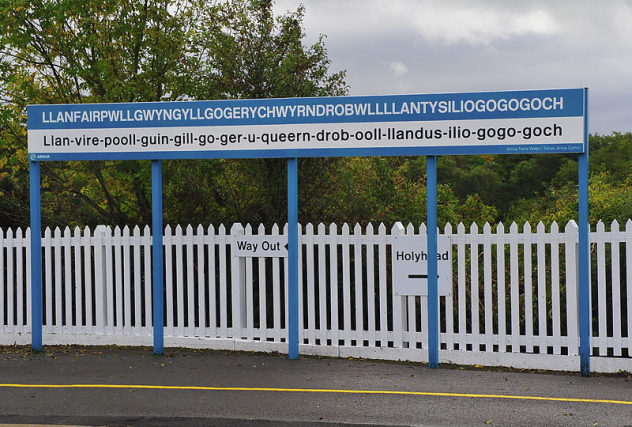10 Japanese Is Unique And Impossible To Learn
Many Japanese have long believed that the Japanese language is both unique and impossible for foreigners to truly understand. This forms a part of “Nihonjinron” (Japanese Theory), which emphasizes the special nature of the Japanese culture and people that supposedly makes them unlike any other on the planet. Nihonjinron claims that the Japanese language is homogenous and intimately tied with the Japanese race and culture and therefore has a pure and spiritual link to the people. Popular views of the futility of foreigners attempting to understand Japanese run like this: “[The] language barrier accounts for nine-tenths of the Asiatic mystery,” and “Anyone who has acquired by some gruesome brain manipulation the faculty to speak Japanese realizes how futile were his efforts.” Most of Nihonjinron’s arguments are laughably false. Japanese is not homogenous; it is divided into dozens of different dialects, which makes sense for a country of mountainous islands. The national prestige language, hyojungo, was originally based on the Tokyo dialect, but even the capital has since developed its own way of speaking. Japanese isn’t even an isolated language: the Ryukyuan language of Okinawa is completely unintelligible to Japanese speakers and preserves features from Old Japanese from before it diverged in the sixth century AD. As for the idea that Japanese is unique, it stems from a tendency to compare the language with European languages and boggle over difference. However, when compared to world languages in general, the linguistic structure of Japanese is not particularly unusual. Finally, while written Japanese is difficult due to the use of four different writing systems (kanji, hiragana, katakana, and romaji [Roman letters]), spoken Japanese is considered relatively easy thanks to consistent rules of conjugation, an efficient vocabulary, and the fact that, to the Japanese, taking long pauses in the middle of a conversation while trying to remember a word looks like you’re being profound rather than horribly awkward.
9 French Is More Logical
The myth that French is a clearer and more logical language has been propagated over the past four centuries by, unsurprisingly, the French. In 1647, the acclaimed French grammarian Claude Favre de Vaugelas said, “We in everything we say follow exactly the order of logical thought, which is the order of Nature.” The idea was that the French grammar system possessed a natural logic and clarity that other languages, even Latin, messed up with ambiguity and inarticulateness. Some linguists even saw the complex perfection of the French language as a reflection of civilization itself. These ideas have since been taken up by both the French and Francophiles abroad. Rapper MC Solaar’s “Pour la beaute de la langue francaise” stands as evidence of this. However, the problem with this whole idea lies in the fact that while human language is necessarily linear, human logic and perception is not. When we see a bear eating a taco, we perceive it holistically as a whole concept, without reference to the linguistic process of bear (subject)—eat (verb)—taco (object). Any language can be expressed with logic and clarity, and any language, including French, can be expressed incoherently, as anyone who has tried to talk to the people selling cheap souvenirs under the Eiffel Tower can attest.
8 Chinese Characters Are Ideograms
An ideogram is a symbol able to convey an idea directly to the mind without the detour of speech-based language, like a “No Smoking” symbol or a skull and crossbones. European thinkers have believed for hundreds of years that Chinese characters do just that, with the Jesuit missionary Matteo Ricci calling Chinese writing “similar to the hieroglyphic signs of the Egyptians [and] each word has its own hieroglyphic character.” The idea was that Chinese characters could be read, and the meaning understood, by anyone who knew the meaning of the symbol, bypassing language and giving pure meaning by calling up images directly into the mind. While the concept inspired linguists and philosophers, it was a gross oversimplification of Chinese characters, conflated with popularly held ideas about ancient Egyptian hieroglyphics. It is impossible to completely separate writing from speech and still express complex or meaningful concepts. Chinese characters include parts called phonetic components and semantic components. Phonetic components are parts of a character that help indicate how it is meant to be pronounced, while signifying components are parts of a character that suggest the word’s meaning. Characters that lack those two components make up only around 15 percent of characters, and they are usually used as phonetic components in other characters themselves. As for the idea that characters can be used as a universal form of communication: It is an exaggeration. It is true that characters can sometimes be used to communicate between speakers of different Chinese dialects, but the differences in vocabulary usage mean that this is not a foolproof means of communication. The simplification of characters and the restriction of education to Beijing-based national language putonghua has caused further estrangement between written Chinese and dialects. Between languages, it is even more treacherous: One character means “mother” in Chinese but “daughter” in Japanese. For words composed of multiple characters, the differences are even more extreme: One word is composed of characters that ostensibly mean “hand” and “paper.” In Japanese, this is tegami, (letter), and in Chinese, it’s shouzhi, (toilet paper).
7 Welsh Is Unpronounceable And Archaic
It is a common source of English humor that Welsh is a dying language that lacks vowels and is impossible to pronounce without spitting everywhere. This was a source of considerable wit by unlamented former BBC loudmouth Jeremy Clarkson, who said, “What’s the point of Welsh for example? All it does is provide a silly maypole around which a bunch of hotheads can get all nationalistic,” and “Fair enough if a bunch of pasty-faced ginger separatists insist on conversing in their native tongue, that’s their lookout but for the rest of us it’s baffling and even dangerous. Please drive slowly appears as ‘gyrrwch yn ofalus’ but by then you’re through the village anyway.” This is not a new sentiment either; in 1749, English traveler John Torbuck described the Welsh language as “a tongue not meant for any mouth; as appears by instance of one in our company who, having got a Welsh polysyllable into his throat, was almost choked by consonants, had we not, by clapping on his back, made him disgorge a guttural or two, and so saved him.” Welsh is, in reality, known as Cymraeg. Welsh is a Germanic word meaning “foreigner” and is actually a reasonably phonetic language that is pronounced as it looks and spelled consistently once you learn the rules. English, on the other hand, is notorious for its downright chaotic spelling conventions. Welsh merely appears intimidating to English speakers because it uses different principles, but those principles are not worse. In fact, they are significantly easier to pick up. The lack of vowels is a specious charge, given that English has five, while Welsh has seven distinct vowels. Famously long and incomprehensible place names are due to the cultural tendency for long, descriptive place names. The famous village of Llanfairpwllgwyngyllgogerychwyrndrobwllllantysiliogogogoch translates as, “The Church of St. Mary by the pool with the white hazel near the fierce whirlpool by St. Tysilio’s church and the red cave.” Even this example is contrived; the village’s original name was Llanfairpwllgwyngyll, meaning “St Mary’s Church In The Hollow Of The White Hazels,” and was pronounced “thlann vyre pooth.” The longer name was merely chosen as an 1860s publicity stunt to create the longest train station name in the British Isles . . . and now, the longest URL.
6 Ebonics Is Lazy English
Many people in the United States, usually white people, believe that Ebonics, or African American Vernacular English (AAVE), is nothing more than poor grammar, lazy pronunciation, and slang. In 1996, an Oakland, California, school tried to recognize AAVE as a distinct dialect for educational purposes, and uninformed people across the country were outraged. The Economist even referred to it as “The Ebonics Outbreak,” a distasteful reference to an outbreak of the Ebola virus in Zaire. People were horrified at the idea that people were suggesting teaching an “inferior” form of English in classrooms. The only problem was that, from a linguistic point of view, there is nothing that makes Standard English better than AAVE. AAVE has consistent grammatical and pronunciation features that mark it out as a legitimate English dialect. Standard English proponents point to the use of double negatives in AAVE as evidence of its inferiority, such as “I ain’t got none,” but are curiously silent about French double negation: “Je n‘en ai pas.” AAVE even enjoys grammatical features that Standard English lacks, such as the imperfect tense, which usually refers to habitual actions or states. Therefore, the sentence, “He crazy, but he don’t be crazy” would be translated into Standard English as “He is currently acting crazy, but he’s not usually crazy.” These nonstandard constructions may appear lazy and incorrect to people who can only speak Standard English, but linguists have been able to work out the grammatical rules unique to AAVE, meaning that it’s not so much “bad English” as it is a different form of English. While many believe that students should only be instructed in the standard dialect, studies have shown that this isn’t the best way to see improved outcomes. Educational studies in Sweden and Norway have shown that teaching in a vernacular language (such as Ebonics and nonstandard Swedish or Norwegian) helps students learn to read faster and retain information better than forcing them to study in the standard dialect.
5 The French Have The Most Fiercely Protective Language Policy
It is common to hear of the French Academy’s beleaguered attempts to prevent the spread of Franglais introduced through American cultural imports, as well as their desperate attempts to stamp out such terrible national threats as the word “hashtag.” But the French aren’t even the most protective of their language in the Francophone (French-speaking) world. Quebec holds that title, where laws were passed to protect the right of workers to communicate in French and force companies with more than 100 employees to have a “Frenchification committee.” In France, while a section of the Ministry of Culture exists to monitor the influx of foreign words and suggest French alternatives, their recommendations are not law and don’t have to be followed by anyone. Meanwhile, most other countries in the world have their own language protection policies in place. In the United States, for example, 35 states have declared English the national language due to fear of Spanish. Iceland has had a policy of linguistic purism since 1780, which demanded the development of foreign words into Icelandic words. They achieved this in a number of ways: Calquing refers to combining native root words into a compound word matching the entymology of a foreign word. (“Amber” and “power” combine as rafmagn, [electricity]). Formal hybridity is combining native and foreign root words. Phonosemantic matching involves matching foreign words with variants of native words with similar sounds and meaning. (AIDS translates as eydni, from the word eyda [to destroy]). Finally, obsolete words are revived and given new meanings. Examples of the last method include tolva (computer), combining “number” with an obscure word from the Eddas meaning “soothsayer” and flugfreyja (stewardess), which combines “fly” with the name of the Norse love goddess Freya. The legacy of the strict policy allows schoolchildren to readily comprehend 12th-century Viking sagas. Meanwhile, North Korea banned most foreign words, as well as the use of Chinese characters, after 1949 and has criticized the South’s language for its loanwords from English and Japanese, as well as intonation filled with “nasal twangs favored by women to coquette with men.” South Koreans mock the North’s awkward constructions designed to avoid using foreign words, such as bulal, which means “light bulb” in North Korea but “testicle” in South Korea. The divide between the countries has become so severe that Northerners living in the South have to take tutoring programs to adjust.
4 The Spanish King’s Lisp
One of the most significant differences between Castilian Peninsular Spanish and the Spanish spoken in Latin America is the use of the zeta sound, the unvoiced interdental which appears in English as a hard “th.” Words that are pronounced with a “th” in Spain are pronounced with an “s” in Latin America. Legend has it that the difference was due to a desire to emulate the speech patterns of a king who suffered from a lisp, usually identified as either Alfonso X or Felipe II. While an entertaining story popular in US Spanish classrooms and stand-up comedy routines, it is completely false. For one thing, the “s” sound still exists in Peninsular Spanish. People in Madrid only use the “th” sound for words that begin with “c” or “z,” while “s” is just pronounced like an “s,” which would make no sense if it was all due to a lisp. In medieval Spain, the letter “c” was pronounced “ts,” the letter “z” was pronounced “dz,” and the letter “s” was always “s.” In most of Spain, “ts” and “dz” eventually became “th,” but in southern Spain, the pronunciation of the letters “c,” “z,” and “s” all merged into the “s” sound. This process was unrelated to and asynchronous with the reigns of the two supposed lisping kings. During the Spanish colonization of Latin America, many migrants came from the Andalucia region of southern Spain, so the “s” pronunciation became standard across the board in the New World, while the use of “th” only exists in Peninsular Spanish. ¿Tienes thentido?
3 British English Is The Original English
It is commonly assumed that the Received Pronunciation (RP) spoken in the UK is the original English, while other forms of English, such as American, Australian, New Zealand, and South African, have diverged from this pure form of English. In reality, the dialect of English used in the British Isles has changed much more significantly over the last three centuries than standard American English. In the 1700s, the English used in both London and the North American colonies was rhotic, meaning that the letter “r” is pronounced after a consonant or at the end of a word. Americans still speak this way, but in 19th-century Britain, non-rhotic speech (which dropped the “r” in words like “hard” or “far”) became standard. This style of speech was associated with the upper classes and became standardized into Received Pronunciation, which was considered easy to understand. Through colonialism, mass education, and the BBC, non-rhotic English became standard in the British Isles and many of its colonial holdings. Some areas of the United States that had close ties with southern England during the colonial period, such as New England and parts of the South, also picked up the non-rhotic habit. Colonists in other parts of the United States often came from Ireland, Scotland, and rhotic-speaking regions of England, which led to the retention of rhotic speech in the General American accent today. In recent years, there has been a movement to perform Shakespeare’s plays in what is referred to as Original Pronunciation, our best reconstruction of what we believe Elizabethan English would have sounded like. While the results are very different from either main form of modern English, they exhibit features that have far more in common with American English, including the rhotic “r” and a flat “a” vowel sound in worlds like “bath” or “France.”
2 Primitive Cultures Have Primitive Languages
There is a common misconception that human cultures with a lower level of material development would have correspondingly simple language systems. This is where we get the idea of caveman speak and stories of isolated African tribes that communicate in grunts and gestures. These so-called primitive languages are meant to be characterized by a lack of vocabulary and abstract terms, irregular and minimal grammar, a tendency toward rapid, random change, and being overall less complex and expressive than languages of more advanced cultures. The idea is often linked with the notion that nonstandard forms of languages used by low-income groups are similarly handicapped. This is entirely inaccurate. Linguists have proven that all languages are equally well-equipped to allow for their speakers to express what they want to say, and many cultures with a low level of material development have staggeringly complex and eloquent languages.
1 Chinese Is A Single Language
Most people assume that Chinese is a single, monolithic language spoken by over 1.3 billion people. Others may be able to distinguish between Mandarin and Cantonese, thanks to the cultural influence of Hong Kong cinema. Indeed, the Chinese government helps to advance this notion, identifying Mandarin as the standard language and everything else spoken as mere dialects. In reality, however, there are dozens of different languages spoken in China, which differ more from the standard Mandarin than different European languages do from one another. The largest non-Mandarin dialect is Wu, spoken in Shanghai and the provinces of Zhejiang, Jiangsu, Anhui, Jiangxi, and Fujian. This dialect is generally called Shanghainese, while linguists call it Wu after the ancient kingdom of Wuyue. Other speakers of Chinese consider it a soft and flowing language, but are often put off by Shanghai peoples’ refusal to speak Mandarin. Cantonese, spoken in Hong Kong, Macau, Guangdong, Guangxi, and Hainan, is a nasal language with long vowels and nine tones and is considered to have preserved a number of features from the Classical Chinese language. Tang dynasty poetry often rhymes when spoken in Cantonese, but rarely in Mandarin. Other languages still used by millions in China include Hokkien, Jin, Hunanese, Hakka, and Gan. In the early 20th century, Shanghai intellectuals pushed for a single national language in order to facilitate communication across the vast country. This backfired on them, as the widespread and relatively easy Mandarin language was chosen, which led to the systematic repression of all other forms of Chinese. However, these languages are still spoken by millions of people in China and by overseas Chinese communities around the world. To get an idea of just how different the languages are, let’s have a look at the following comparison: English: Hello! Have you eaten? Mandarin: Ni hao! Ni chifan le ma? Wu: Nong haw! Nong qi gu le va? Cantonese: Leih hou! Leih sik dzo fan mei a? Hokkien: Li ho! Chiah pa bue? Hakka: Ngi ho! Ngi siit-de fan lo? David Tormsen speaks English, Korean, okay Chinese, rude French, and a bit of American. Drop him a line at [email protected].
























